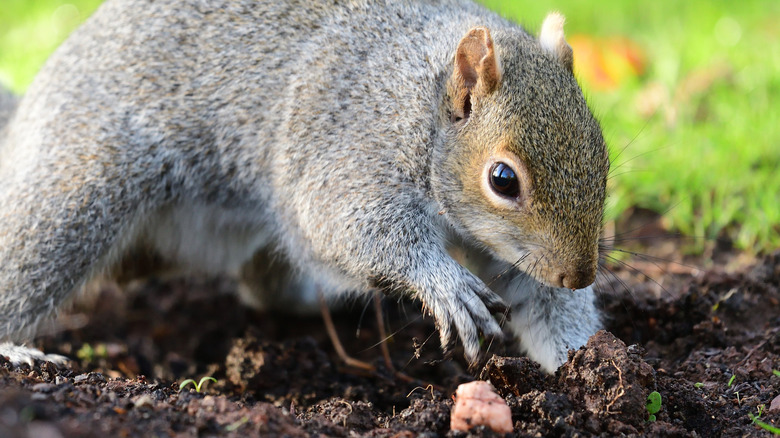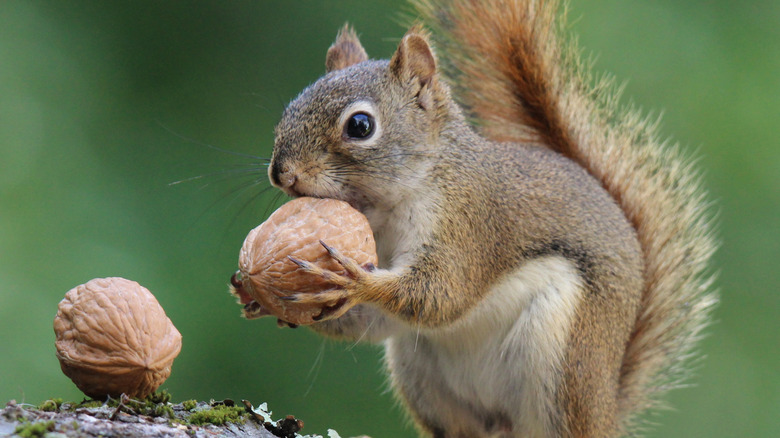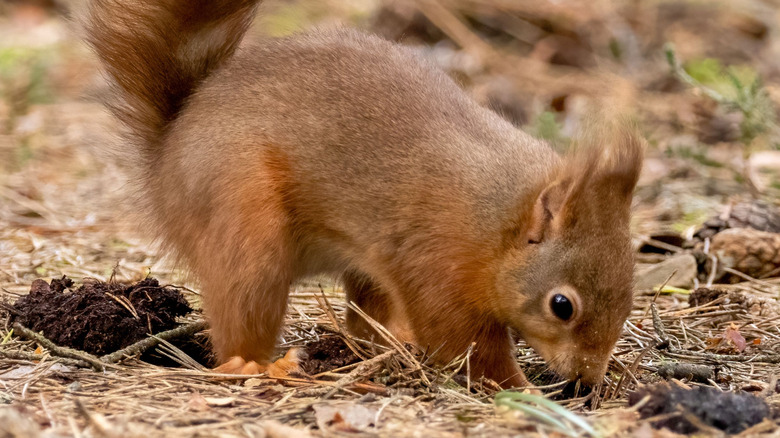These Theories Explain Why Squirrels Bury Some Nuts But Not Others
Squirrels have some mysterious behaviors. For instance, the reason these rodents run in front of cars is a defensive tactic that they use to evade predators (although it's no match for speeding vehicles). Another peculiar behavior is that they eat some nuts but decide to bury others. Scientists are still working out why squirrels do this and how they decide, but some theories revolve around consumption time, perishability, and tannin content.
It's no surprise that all types of squirrels bury their nuts — either in one big stock or in scattered locations — and some researchers think it's because those nuts take longer for the animals to eat. In a 1992 study published in Animal Behaviour, Dr. Lucia F. Jacobs observed what five hand-raised grey squirrels did with shelled hazelnuts and blocks of laboratory rodent chow. The animals seemed to estimate the time cost of eating versus caching and opted for the less time-consuming action. The squirrels opted to eat the hazelnuts, but the rodent chow, which took longer to eat, tended to be cached away, despite the fact that the rodent chow would go bad quicker than the hazelnuts.
The perishability theory
While Dr. Jacobs' study found that the rate of a nut's deterioration seems to have little bearing on whether squirrels eat or bury nuts, some scientists disagree. The researchers of a 1996 study also published in Animal Behaviour discovered that the decay rate does influence the animal's decision after all.
As one of the types of foods squirrels eat, nuts only last so long before they begin to go bad. For instance, acorns from red oak trees germinate during spring after being dormant through winter, which makes them slow to deteriorate. White acorns, on the other hand, germinate during the fall season not long after maturing, so they go bad faster.
When free-range grey squirrels were given red and white oak acorns in six separate experiments, they consistently ate the white acorns right away and buried the red acorns. The rodents also removed the embryo — which controls maturation — from the red acorns before burying them so that they couldn't germinate and would last longer in storage. These results indicate that the perishability of the nuts have a much bigger effect on the grey squirrels' decisions than handling time.
The tannin theory
Many animals dig in the ground for various reasons. While returning to its cache of food is how a squirrel survives the winter, burying some nuts is how the animal makes them safer. That's because nuts have varying amounts of tannins, which are naturally occurring polyphenol chemicals that change the shape of gut enzymes. Since tannin-altered enzymes no longer work correctly, animals that consume tannins could suffer from malnutrition. Tannins can also prevent water absorption, which can lead to dehydration, ulcers, and kidney issues.
Studies have shown that the tannins of foods that are buried can leach out over time, reducing their toxicity. Researchers have observed this when monitoring various animals and the high-tannin foods that they bury to eat later. In a 1986 study published in Ecology, scientists added tannins to food made from white oak acorns. They found that grey squirrels would eat more of the food that had a lower amount of this chemical than the food with a higher amount.
However, since the high-tannin food didn't appear to have adverse effects on the grey squirrels' ability to digest protein, the study researchers hypothesize that they use the tannins to estimate the deterioration rate of nuts. So, in the end, it could be that squirrels use consumption time, perishability, and tannin content to decide whether or not to bury their food — and which comes first seems to be up for debate.


